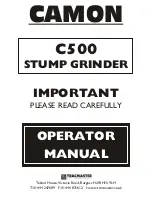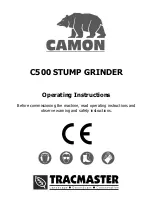
-24-
SANDING WOOD
When sanding wood the direction of the disc
motion at the contact point should parallel
the grain as much as possible. The rapid cut
of discs and the swirl type scratch pattern
they occasionally create generally prohibit
their use for producing the final finish.
Scratches and circular marks are usually the
result of using too coarse a grit. When
changing to a finer grit, move across the sand -
ing lines that were made by a previous
coarser disc.
SANDING METAL
When sanding automobiles or appliances,
wipe the metal clean with a non-flammable
solvent or commercial cleaner to remove all
wax and grease. By doing this first, the
sanding discs will sand better and last longer.
For heavy duty work, use a coarse grit disc
first. Follow-up with a medium grit to remove
scratches. To produce smooth finish, use fine
grit disc.
Operating Instructions
Wire Brush Operations
Wire brushes are intended to “clean”
structural steel, castings, sheet metal, stone
and concrete. They are used to remove rust,
scale and paint.
A v o i d b o u n c i n g a n d
snagging the wire brush,
especially when working corners, sharp
edges etc.
This can cause loss of control and
kick-back.
BRUSHING PRESSURE
1. Remember, the tips of a wire brush do
the work. Operate the brush with the
lightest pressure so only the tips of the
wire come in contact with the work.
2. If heavier pressures are used, the wires
will be overstressed, resulting in a wiping
action; and if this is continued, the life of
the brush will be shortened due to wire
fatigue.
3. Apply the brush to the work in such a way
that as much of the brush face as possible
is in full contact with the work. Applying
the side or edge of the brush to the work
will result in wire breakage and shortened
brush life.
WIRE CUP BRUSH
CORRECT:
Wire tips
doing
the work.
INCORRECT:
Excessive
pressure can
cause wire
breakage.
WIRE WHEEL BRUSH
CORRECT:
Wire tips
doing
the work.
INCORRECT:
Excessive
pressure can
cause wire
breakage.
















































